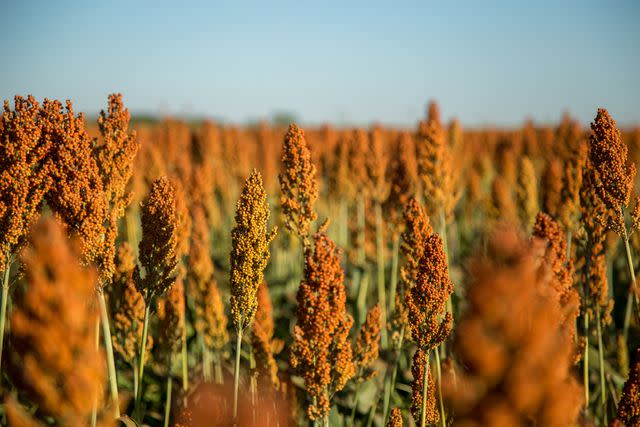What Is Sorghum?
Bake, boil, drizzle, and pop—sorghum is an ingenuous ingredient that can be used for much more than slathering on biscuits.
Fact checked by Jennifer HawkMedically reviewed by Jerlyn Jones, MS, MPA, RDN, LD, CLT
Sweet, dark sorghum syrup-soaked pancakes, biscuits, or cornbread is a true Southern specialty, but the plant also produces grains that can be boiled and eaten as a starchy side or milled and turned into a gluten-free flour. An ancient grain, the ingredient is basically unchanged since it was first cultivated. So why is it plentiful in the South, and how is it used today?

Getty Images
What Exactly Is Sorghum?
A cereal grain originally from Africa, sorghum is an essential crop in the United States today. It can be eaten as a grain, popped into a type of popcorn, and grown for commercial use for agriculture feed and ethanol production.
Grown in the South and Great Plains, sorghum is sometimes mistaken for corn, as the two crops closely resemble one another until fully mature, and both are beloved by farmers for their drought resistance. While often a staple food in the Global South (Africa and India), folks in the United States are cottoning onto the many benefits, including its lack of gluten, making it perfect for individuals with celiac disease and gluten intolerance.

Getty Images
So Then, What Is Sorghum Syrup?
With a thick consistency and a dark brown hue, sorghum syrup is often confused for another favorite Southern sweetener, molasses. Many Southern folks of a particular generation have a nostalgic association with the flavor of sorghum syrup.
Sorghum syrup, sometimes called sorghum molasses, was often used as a sweetener in commercially baked goods to reduce costs. In your own baking, substitute equal amounts of corn syrup, molasses, honey, or other liquid sweeteners in place of sorghum if you do not have any on hand. Ideal for pies, cookies, cakes, muffins, or to sweeten drinks like cocktails, sorghum pairs nicely with winter baking spices like cinnamon and nutmeg.
Sorghum vs. molasses
Sorghum is refined from the stalks and juices of the sorghum plant. It has a slightly sour but sweet flavor.
Molasses, on the other hand, is a product of the sugar cane refinement process. It too can be sweet with hints of sourness, even saltiness. So despite their common consistencies and color, these are not close cousins.
What does sorghum taste like?
Recipe developer and founder of WinniE’s Bakery, Elise Smith, shared her first memory of sorghum: “My first memory of tasting sorghum molasses is quite vivid! I was doing just that, tasting alternative sweeteners. And, wow! Its texture is smooth and thick, although more fluid in consistency than traditional molasses, with a light and smoky mouth feel. I really enjoyed it!"
Try using sorghum syrup in savory dishes, too; this vinaigrette gets a balanced sweetness from the sorghum or helps caramelize winter veggies with a drizzle. Smith shared, “[Sorghum molasses] is the 'secret' ingredient in a lot of the BBQ sauces and dressings we buy at the store.”
Syrup-making festivals are held across the South from late summer to early fall. These events showcase traditional methods for pressing the syrup (sometimes called syrup sopping) and are a great way to get pure product. Look for 100 percent sorghum syrup when shopping.
Where To Use Sorghum Grains
Swap sorghum grains for quinoa or rice in your next salad or side. Like other newly popular ancient grains—think farro and barley—sorghum has a chewy texture and a nutty flavor. Simply boil a salted pot of water and cook the sorghum in the same manner as pasta. Sorghum cooks longer, typically 50 to 60 minutes, but requires less fussing than rice.
Corn kernels aren’t the only grains that can be popped. Sorghum pops up, too. Stick the sorghum kernels in your air popper or microwave for your next movie night or gathering, or order some sorghum popcorn from Chasin’ Dreams or Poplettes.
The grain and the milled flour are gluten-free, making it an ideal choice for people with celiac disorder or gluten-intolerant folks. Substitute sorghum flour for all-purpose flour in baked goods, though you will require a binding agent like xanthan gum or cornstarch for thickness. Batter chicken or fried green tomatoes with the flour as the texture provides a crispy coating.
For more Southern Living news, make sure to sign up for our newsletter!
Read the original article on Southern Living.

